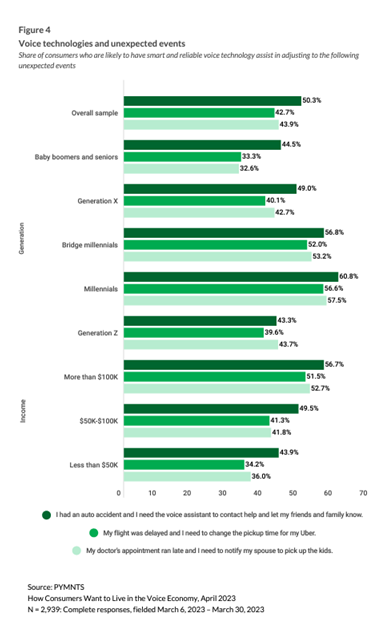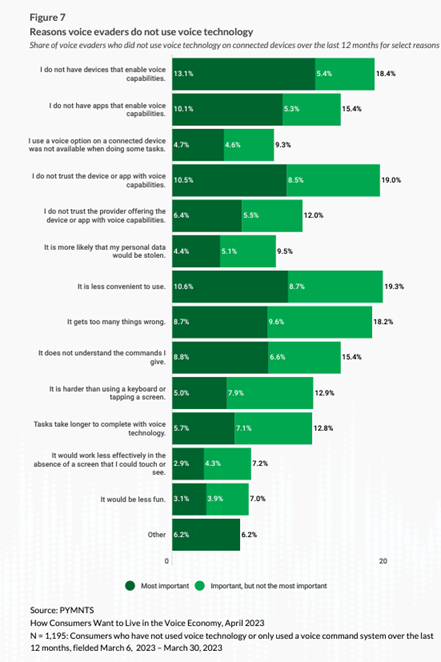Almost Half of Consumers Want Voice AI Tech to Manage Schedule Changes

Trust and capability considerations continue to rank high on the list of concerns limiting broader adoption of technology.

Smartphones are a technological marvel with a searing practical limitation: touchscreens. These all-but-essential computers can quickly become all but useless when in the rain or when consumers have hands that are wet, dirty, gloved or otherwise occupied. This can leave consumers frustrated, and with no major plans for advances in touchscreen durability (beyond folding screens) on the horizon, the next evolution may use a different tool entirely: voice technology, specifically modern iterations that are increasing powered by generative artificial intelligence (AI).
Despite touchscreens’ ubiquity, consumers recognize the benefits of voice technology for emergency or otherwise unexpected events where successful touchscreen use is not an option, per data in PYMNTS’ “How Consumers Want to Live in the Voice Economy” report.
Just over 50% of consumers would use smart and reliable voice technology in the event of an emergency such as an auto accident if they needed help contacting help or loved ones. The rates of this openness to use is strongest in millennials, followed by bridge millennials at 61% and 57% respectively, compared to other generations. This may be due to these age cohorts’ willingness to use voice technology overall, which itself may be due to its possible time saving an convenience factors. But why isn’t the technology as popular outside of emergency situations?
The below chart for the same report notes some common themes in consumers’ hesitance to more broadly adopt voice technology. Aside from ability to access the innovation, most other concerns center around data protection and reliability. The second-highest reason consumers cited for adoption hesitancy was trusting a device or app with voice technologies, with 19% of those surveyed sharing the sentiment. Other overall high-ranking concerns included 18% of consumers saying voice technology gets too many commands wrong and 15% saying the tool doesn’t understand their commands.

Part of this hesitancy may be rooted in past experiences. In an interview with PYMNTS’ Karen Webster, CEO and co-founder of conversational intelligence platform SoundHound Keyvan Mohajer detailed why some consumer hesitancy to trust voice-powered technology.
“[When voice AI first started] consumers wanted to have those sci-fi-style, open-ended conversations [with robots], and many were disappointed because the tools at that time could only play music, set timers, tell you the weather.”
However, those days are past and the potential of voice-powered technology is just beginning to be discovered. In a PYMNTS editorial, Webster describes the future potential of AI-powered voice technology. “Artificial intelligence will make voice interactions smart, personalized, adaptive and engaging. As in truly engaging — conversational in every sense of the word. Not just reactive to a wake word and a series of prompts, but proactive and intuitive, anticipating actions based on history and context and anticipating what consumers might want to do next, just like an effective, smart, capable human assistant would do.”
Consumers may still carry hesitation about the reliability and safety of voice technology, but as the AI-powered tools gets “smarter” and capable devices becomes more available, those views could change, and the tech may become a more regular tool in everyday life. When it comes to AI’s potential to revolutionize how consumers communicate, the future could well be now.

